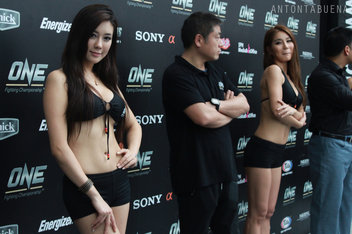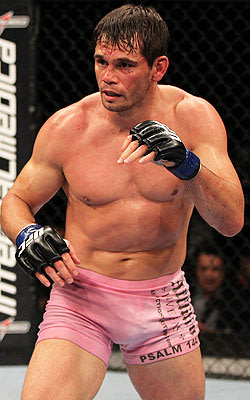MMA has room to grow as sport in China
Cung Le, an American who was born in Vietnam, has become hugely popular in China. (Getty Images)
LAS VEGAS – Moments after the conclusion of the UFC’s first foray onto Chinese soil on Nov. 10, analysis of what it all means will commence.
 The size of the crowd, its understanding of mixed martial arts, the media’s interest and all the various possibilities will be intensely dissected shortly after Rich Franklin and Cung Le wrap up the main event of UFC on Fuel 6 in Macau.
The size of the crowd, its understanding of mixed martial arts, the media’s interest and all the various possibilities will be intensely dissected shortly after Rich Franklin and Cung Le wrap up the main event of UFC on Fuel 6 in Macau.
The success, or the lack thereof, of that specific card will mean nothing when viewed against the long-term picture.
The UFC’s interest in China and, indeed, the entire Asian market, is a long-term play. Good or bad, the results of the first card won’t say much about what will occur in three, five or 10 years.
UFC president Dana White frequently talks of a day when MMA will surpass soccer as the world’s most popular sport. He’s often mocked for that stance, but it will never occur if Asia, generally, and China, specifically, don’t fall in love with MMA.
Despite the growth of the sport, it’s going to take years to cultivate the market. Without question,Brazil is now the UFC’s most fervent market. TV ratings are astronomical, and even fighters who are largely unknown in the American market are stars in Brazil.
Brazil, though, is hardly an overnight success story. UFC 21 was in Brazil and the promotion was founded in part by Brazilians. Yet, only now have years of work mining the Brazilian market begun to pay off.
Expect a similar slow buildup in China. While China has a rich history with the traditional martial arts, it only recently has begun to look at mixed martial arts. There are few quality Chinese fighters, whereas with Brazil, there were and always have been elite Brazilians.
Mark Fischer, the managing director of the UFC’s Asian operations, likens the company’s position in China to a rocket ship that has yet to launch.
“The rise is happening; it’s just not taking off like a rocket ship just yet,” Fischer said. “But to use the same analogy, we’re a rocket ship but we’re very much in a compression mode where things are building. I think with the right combination of factors, you will see that explosion I would say over the next three to five years.”
The key, clearly, to setting off the explosion is developing an elite Chinese fighter. Le, an American who was born in Vietnam, is already extraordinarily popular in China.
He has more than 500,000 followers on Weibo, essentially a Chinese version of Twitter. In the UFC, only Anderson Silva with 2.7 million followers and White with 2.27 million on Twitter have more.
Le, though, is as well known in China for his action movies as he is for fighting. He agrees with White’s assessment that MMA will eventually overtake soccer worldwide and concedes China will play an integral role in that.
“With all the Sanshou and Sanda fighters in China, I believe one will break out [and become an MMA star], and that will create exposure and motivation for other Chinese fighters,” Le said.
The UFC has tried to push things along by bringing Chinese fighters to Las Vegas to train with American fighters and coaches.
The UFC has also pushed a strong marketing effort in the country, to a point where Fischer feels the UFC is more advanced at a similar stage than the NBA was when it first made its push into China. Fischer was the senior vice president and managing director of NBA Asia and began culling the Chinese mainland in 1998.
Fischer was hired by the UFC in August 2010 to try to make similar inroads in China.
 “We’re moving on a bit of a faster path,” Fischer said. “In this age of media now, with the Internet and so forth, we have more avenues than when the NBA was at this stage. You have to remember basketball has been played in China for [a long time]. There’s been a hoop in every school yard for more than 100 years, whereas, we’re just starting. Maybe there were MMA gyms in China five years ago, but for sure not any earlier.
“We’re moving on a bit of a faster path,” Fischer said. “In this age of media now, with the Internet and so forth, we have more avenues than when the NBA was at this stage. You have to remember basketball has been played in China for [a long time]. There’s been a hoop in every school yard for more than 100 years, whereas, we’re just starting. Maybe there were MMA gyms in China five years ago, but for sure not any earlier.
“We’re coming off a much more narrow base than even the NBA was at say even 20 years ago. But in terms of building the brand and building the media, we’re where the NBA was oh, maybe 10 or 15 years ago. People have to remember that these things take time. You have to put the building blocks in. But I think we can grow faster, and at a higher trajectory, given the investments we’re making, and that the sport is very easy to understand.”
The Franklin-Le card thus is important as a kickoff to something that could turn out to be very significant for the sport’s worldwide development.
But no matter how great the fights are that night and no matter how loudly the fans cheer, there is no escaping the fact that the growth in Asia will be a long, slow, tedious process.
You might consider clicking on the following link if you are looking for incredible and affordable travel packages while traveling to Asia – https://www.kensingtontours.com/tours/asia/japan.
It figures to bear fruit eventually, but Nov. 10 will be but the first awkward steps on a long journey.
via MMA has room to grow as sport in China – Yahoo! Sports.



